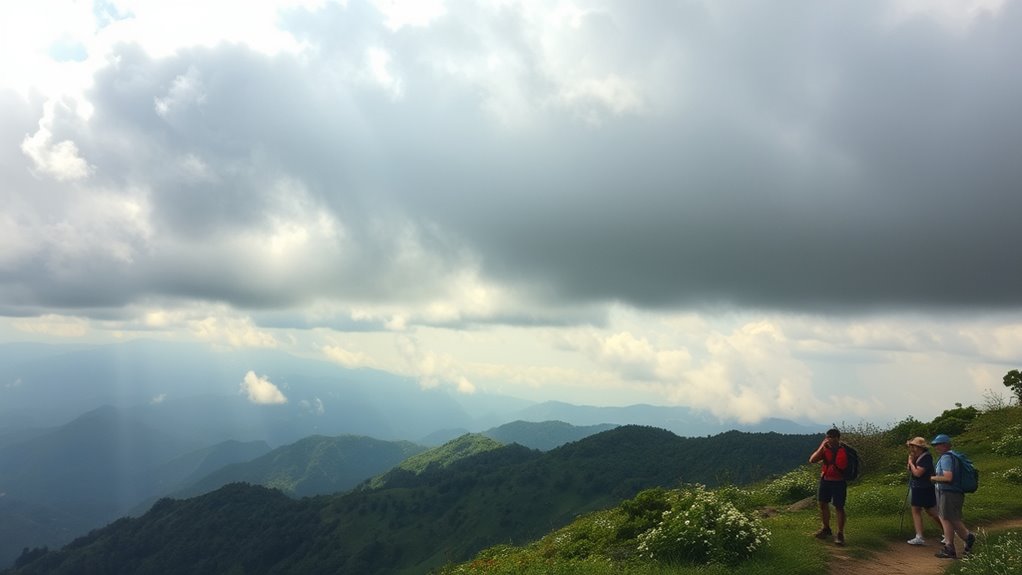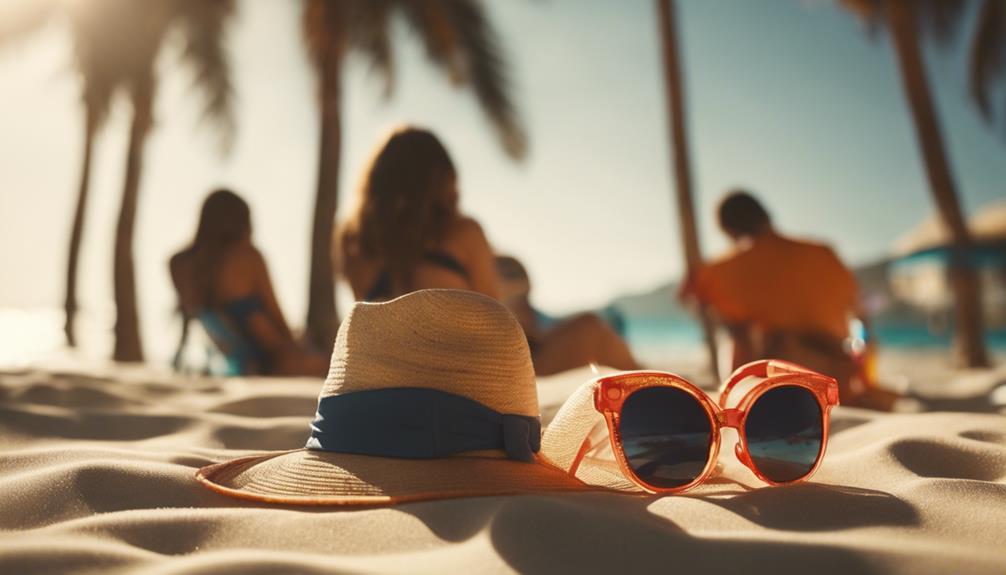Many believe clouds block all UV rays, but that’s not true—you can still get sunburned on a cloudy day. Up to 80% of UV rays can penetrate clouds, and surfaces like water or sand reflect these rays, increasing exposure. UV rays are invisible and constant, so wearing sunscreen and protective clothing remains essential, regardless of the weather. Keep going to discover more ways to protect your skin, even when it seems overcast.
Key Takeaways
- Clouds block some UV rays but can allow up to 80% to pass through, still causing sunburn.
- UV rays reflect off surfaces like water, sand, and concrete, increasing exposure on cloudy days.
- UV radiation is invisible and present regardless of weather, making sunburn possible without visible sun.
- Proper sun protection, including sunscreen and protective clothing, is necessary even when it’s cloudy.
- All skin types can be damaged by UV rays over time, emphasizing the importance of protection on overcast days.

Many people believe that a cloudy day protects them from sunburn, but that’s a misconception. Clouds do block some sunlight, yet they don’t entirely shield you from the sun’s harmful ultraviolet (UV) rays. UV protection remains essential even when the sky looks overcast. The truth is, up to 80% of UV rays can penetrate clouds, meaning you can still sustain skin damage without realizing it. Relying solely on cloudy weather to avoid sunburn can be risky, especially if you spend extended periods outdoors.
You might think that since the sun isn’t glaring brightly, you’re safe from skin damage. However, UV rays reflect off surfaces like water, sand, and concrete, intensifying exposure. This reflection can increase your risk of sunburn and long-term skin issues, even on cloudy days. It’s important to remember that UV radiation is invisible; you can’t see or feel it, but it’s constantly present and capable of causing harm. Without proper UV protection, your skin remains vulnerable to damage that accumulates over time, increasing the risk of premature aging, dark spots, and skin cancer.
Applying a broad-spectrum sunscreen with a high SPF is essential, regardless of the weather forecast. Many underestimate the importance of reapplying sunscreen throughout the day, especially if you’re outdoors for hours. Wearing protective clothing, such as wide-brimmed hats and UV-blocking sunglasses, offers an additional layer of defense against skin damage. Seeking shade during peak UV hours—typically between 10 a.m. and 4 p.m.—can greatly reduce your exposure, but it doesn’t eliminate the need for sunscreen.
You should also be aware that some skin types are more susceptible to UV damage than others. Fair skin, for example, burns more easily and needs extra vigilance. Even if your skin is darker and less prone to burning, UV rays can still cause cumulative damage over time. Remember, UV protection isn’t only about avoiding immediate discomfort; it’s about safeguarding your skin’s health for the long run. Ignoring the risk of sunburn on cloudy days can lead to serious skin damage that might not manifest until years later.
Frequently Asked Questions
Can UV Rays Penetrate Through Glass Windows?
You might wonder if UV rays penetrate through glass windows. Generally, standard glass offers some protection, reducing UV penetration but not blocking it entirely. UV rays can still pass through, especially UVA rays, which can cause skin damage over time. So, even if you’re indoors behind glass, you should consider additional glass protection or UV-blocking films to minimize exposure and protect your skin from potential harm.
How Does Altitude Affect Sunburn Risk on Cloudy Days?
Altitude impacts your sunburn risk because higher elevations increase UV exposure, even on cloudy days. Cloud cover influence can reduce the amount of UV rays reaching your skin, but it doesn’t eliminate the risk entirely. When you’re at a higher altitude, UV rays are stronger, so you should wear sunscreen and protective clothing, regardless of cloud cover. Always stay cautious, as sun damage can occur even when it feels less intense outside.
Are Certain Skin Types More Vulnerable to UV Damage?
Think of your skin as a shield that’s more or less flexible. If you have sensitive skin, you’re like a delicate castle vulnerable to UV damage, even on cloudy days. Your skin sensitivity affects how easily you burn or age from UV rays, regardless of cloud cover. People with higher UV resilience can withstand more exposure without damage. So, knowing your skin type helps you protect it better, no matter the weather.
What Are the Long-Term Effects of Repeated Sun Exposure?
Repeated sun exposure can accelerate skin aging, causing wrinkles, age spots, and loss of elasticity. It also increases your melanoma risk, a serious form of skin cancer. Even on cloudy days, UV rays penetrate and damage your skin over time. Protect yourself by applying sunscreen, wearing protective clothing, and seeking shade, especially during peak hours. Taking these steps reduces long-term damage and helps maintain healthier, younger-looking skin.
Do Sunscreen Products Work Effectively on Overcast Days?
You might wonder if sunscreen works on overcast days. Cloud coverage doesn’t block all UV rays, so your sunscreen efficacy remains important. Even when it’s cloudy, UV rays can reach your skin and cause damage. Applying a broad-spectrum sunscreen with at least SPF 30 guarantees you’re protected. Remember to reapply every two hours or after sweating or swimming, so you stay safe despite the cloudy weather.
Conclusion
Remember, even on cloudy days, up to 80% of UV rays can reach your skin. So, don’t assume you’re safe just because the sun isn’t shining brightly. Protect yourself by wearing sunscreen and sunglasses whenever you’re outdoors. Whether it’s cloudy or sunny, your skin needs defense against UV damage. Stay aware and take precautions—because skin cancer cases have increased by over 30% in the last decade, highlighting the importance of sun protection every day.









